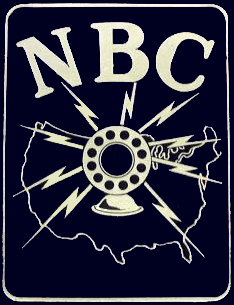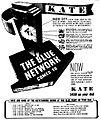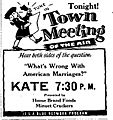NBC Blue Network facts for kids
The NBC Blue Network was an important radio network in the United States. It started way back in 1927. Two big companies, RCA (Radio Corporation of America) and NBC (National Broadcasting Company), worked together to create it. Think of it like one of the first big groups of radio stations that shared shows across the country! Later, in 1945, the NBC Blue Network changed its name. It became what we know today as the American Broadcasting Company, or ABC.
Contents
What Was the NBC Blue Network?
The NBC Blue Network was one of the first major radio networks in America. A radio network is a group of radio stations that broadcast the same programs. This allowed people all over the country to listen to the same shows at the same time. Before networks, each radio station had to create all its own programs. Networks made it possible to share popular shows with many more listeners.
How Radio Networks Began
In the early days of radio, stations were mostly local. They only reached people nearby. But people wanted to hear popular shows from far away. So, companies started connecting stations together. This created "networks."
The Birth of NBC's Networks
NBC was a pioneer in radio broadcasting. In 1926, NBC launched two national radio networks. These were called the NBC Red Network and the NBC Blue Network. The Red Network usually carried more popular and entertainment programs. The Blue Network often broadcast news, cultural shows, and educational programs.
Why Two Networks?
Having two networks allowed NBC to offer a wider variety of programs. It also helped them reach more listeners. Imagine having two different TV channels from the same company! This was similar for radio. The Red and Blue networks operated side-by-side for many years. They were both very successful.
The Government Steps In
In the late 1930s, the United States government started looking at radio networks. A group called the Federal Communications Commission (FCC) made new rules. The FCC decided that one company, like NBC, should not own two national networks. They thought it gave one company too much control over radio. This rule was made to encourage more competition in broadcasting.
Selling the Blue Network
Because of the FCC's new rules, NBC had to sell one of its networks. They decided to sell the Blue Network. In 1943, the Blue Network was sold to a businessman named Edward J. Noble. He bought the network for about $8 million. This was a huge amount of money back then!
Becoming ABC
After being sold, the Blue Network continued to operate. But it needed a new identity. In 1945, the Blue Network officially changed its name. It became the American Broadcasting Company, or ABC. This new name marked a fresh start for the network. ABC grew into one of the biggest broadcasting companies in the world. It now has both radio and television networks.
Images for kids
-
Advertisement placed by the Enna Jettick Shoe Company promoting the appearance of Sir Harry Lauder on its NBC Blue program, December 1, 1929. Note that the text implies that the NBC Blue, NBC Orange (West Coast) and NBC Red networks were all participating in the broadcast.
-
This 1944 advertisement, while it dates from after the sale by NBC of the Blue Network, shows how the Blue Network continued to have access to NBC facilities; in this case, the famed radio studios at Rockefeller Center in New York City
-
Jessie Royce Landis (l) and Celeste Holm (r) pose with a Blue Network microphone in this 1943 publicity still for the show The House on Q Street. Collection of E.O. Costello
-
1944 souvenir booklet for the Blue Network audience participation show Ladies Be Seated, which would continue to have a multi-year run on ABC radio. This show was also one of the first programs to be televised by ABC. A script survives from a February 25, 1945 local broadcast over WRGB, the Schenectady, New York television station of General Electric, hosted by Johnny Olson. The network is referred to in the script as being "The Blue Network of the American Broadcasting Company."
See also
 In Spanish: Blue Network para niños
In Spanish: Blue Network para niños









